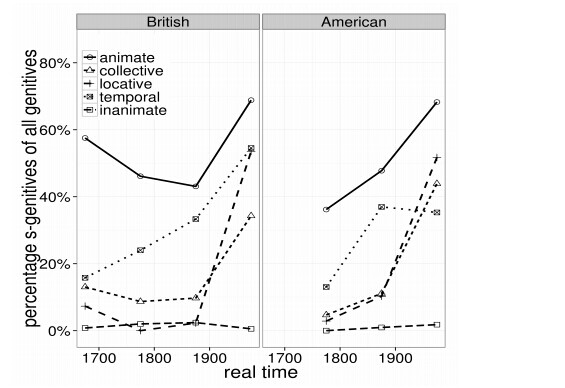“’Animacy’ is an inherent property of concepts and, as a first approximation, it refers to the distinction between living and non-living things or concepts” (Rosenbach 2002:42). The more animate the possessor is, the more likely is the s-genitive to be preferred. In contrast, if the possessor conveys less animacy, the of-genitive is preferred (cf. Rosenbach 2002). Rosenbach (2006: 105) presents an animacy hierarchy: human (girl) > animal (dog) > collective (family, church) > inanimate (chair). There is another animacy scale presented by Quirk et al (1985): personal nouns (brother) > collective nouns (family) > higher animals (cow) > lower animals (ant) > inanimate nouns (box). In the later study, Rosenbach (2008) adds two more possessor animacy categories which are temporal nouns and locative nouns. Temporal nouns refer to nouns which contain both points in time and durations, like February and moment. Locative nouns are locations, including geographical states, like Russia, this kingdom and the seas. Following Zaenen’s (2004) classification scheme, temporal and locative nouns should belong to “inanimate”.
In their latest study, Szmrecsanyi, Rosenbach, Bresnan and Wolk (2014) report that there has been a diachronic weakening of the animacy constraint. By means of logistic regression analysis, they analyzed the development of the animacy constraint in ARCHER. Logistic regression, according to the definition of Szmrecsanyi, Rosenbach, Bresnan and Wolk (2014: 139), “is a multivariate statistical analysis technique that quantifies the effect that individual explanatory factors have on a binary dependent variable, such as genitive outcomes.” The results are shown below:

Figure 2. S-genitive rates (y-axis), as a function of ARCHER time slice (x-axis) and several animacy categories. Left: British English; Right: American English. (Szmrecsanyi, Rosenbach, Bresnan and Wolk 2014: 143)
As shown in figure 2, except inanimate possessors, all other possessor categories like collective, locative and temporal nouns increasingly preferred the s-genitive in both British and American English. The figure also shows that British and American English have a rather similar development of the possessor animacy constraint (Szmrecsanyi, Rosenbach, Bresnan and Wolk 2014: 143).
Szmrecsanyi, Rosenbach, Bresnan and Wolk (2014: 145-146) offer some potential causes for the weakening of the animacy constraint. First of all, there may have been a linguistic change. The s-genitive used to appear only with animate possessors (see chapter 2 in this paper), yet this constraint has been weakened. As Rosenbach (2004) points out, “its weakening may be related to the change of the s-genitive from a purely inflectional marker in Old English to a possessive determiner and referential anchor in late Middle and Early Modern English.” Secondly, the conceptualization of possession and animacy may have changed. It is suggested that the action of possession used to be considered as a human action, that is to say, only humans could “possess”. However, people are accepting that possession could also be associated with other entities, like corporations. Corporations could also be considered animate, but it might depend on people’s perception of the corporations. Thirdly, there may have been a change in environment/cultural context. This suggests that, if the frequency of rarely found entities increases over time, the category divisions between these entities become more ambiguous.
Created with the Personal Edition of HelpNDoc: Create iPhone web-based documentation